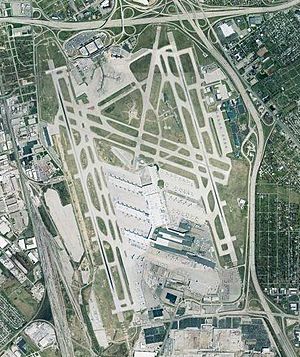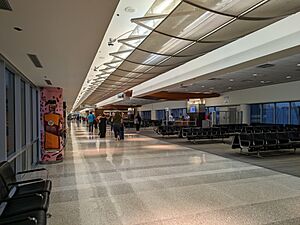Louisville Muhammad Ali International Airport facts for kids
Quick facts for kids
Louisville Muhammad Ali International Airport
Standiford Field |
|||||||||||||||||||
|---|---|---|---|---|---|---|---|---|---|---|---|---|---|---|---|---|---|---|---|
 |
|||||||||||||||||||
 |
|||||||||||||||||||
| Summary | |||||||||||||||||||
| Airport type | Public | ||||||||||||||||||
| Owner/Operator | Louisville Regional Airport Authority (LRAA) | ||||||||||||||||||
| Serves | Louisville metropolitan area | ||||||||||||||||||
| Opened | 1941 | ||||||||||||||||||
| Hub for | UPS Airlines | ||||||||||||||||||
| Elevation AMSL | 501 ft / 153 m | ||||||||||||||||||
| Coordinates | 38°10′27″N 085°44′11″W / 38.17417°N 85.73639°W | ||||||||||||||||||
| Map | |||||||||||||||||||
FAA airport diagram |
|||||||||||||||||||
| Runway | |||||||||||||||||||
|
|||||||||||||||||||
| Statistics (2024) | |||||||||||||||||||
|
|||||||||||||||||||
|
Sources: Louisville Muhammad Ali International Airport, FAA
|
|||||||||||||||||||
The Louisville Muhammad Ali International Airport (SDF) is a busy airport in Louisville, Kentucky. It is also known by its older names, Standiford Field and Louisville International Airport. The airport was renamed to honor Muhammad Ali, a famous boxer who grew up in Louisville. He was a three-time world heavyweight champion.
This airport covers about 1,500 acres and has three runways. Its airport code, SDF, comes from its original name, Standiford Field. Even though it's called an "international" airport, it mostly handles international cargo flights. It is a major hub for UPS Airlines and their huge cargo center, called UPS Worldport.
In 2023, over 4.6 million passengers traveled through the airport. In 2024, this number grew to over 4.8 million passengers. The airport is also incredibly important for cargo. In 2022, over 6.7 billion pounds of cargo passed through it. This makes it the third-busiest cargo airport in the United States and the sixth-busiest in the world! The Kentucky Air National Guard also uses a part of the airport for its C-130 transport planes.
On January 16, 2019, the airport's name officially changed to Louisville Muhammad Ali International Airport. A new logo was shown on June 6, 2019. It features "Ali's silhouette, with his arms up in victory, against a butterfly background."
Airport History
Building Standiford Field
The airport was first built in 1941 by the United States Army Corps of Engineers. They chose a spot south of Louisville that did not flood during the big Ohio River flood of 1937. The airport was named after Dr. Elisha David Standiford. He was a local businessman and politician who cared a lot about transportation.
Early Days and Growth
The Army controlled the field until 1947. Then, it was given to the Louisville Air Board for public use. Before this, Bowman Field was Louisville's main airport. But it was too close to the city to get bigger. So, all commercial flights moved to Standiford Field.
In the early years, passengers used a small brick building called the Lee Terminal. A new, larger terminal opened on May 25, 1950. It could handle 150,000 passengers each year.
Modernizing the Airport
In the 1980s, big plans were made to build a new, modern terminal. This project was called the Louisville Airport Improvement Plan (LAIP). Construction started on a new terminal that cost $35 million. It was designed to handle almost 2 million passengers by 1985. New parallel runways were also built to help with the growing UPS operations. Most of these improvements were finished in the 1990s, making the airport much more modern.
In the 1990s, Southwest Airlines started flying to Louisville. This helped the number of passengers grow a lot. In 1995, the airport's name changed from Standiford Field to Louisville International Airport. Around this time, two new, longer parallel runways were opened. The Kentucky Air National Guard also moved its base to the airport.
Recent Updates
In 2005, the terminal got a $26 million makeover. As of 2025, the airport is working on a huge project called SDF Next. This project includes over $1 billion in upgrades to the Jerry E. Abramson Terminal. These improvements will update the baggage claim, security areas, and rental car counters.
On January 16, 2019, the airport was officially renamed Louisville Muhammad Ali International Airport. This honored the boxing legend and Louisville native, Muhammad Ali.
Airport Facilities
The Terminal Building
The Jerry E. Abramson Terminal is where all the passenger flights arrive and depart. It has two floors. On the first floor, you'll find ground transportation and baggage claim. The second floor has ticketing counters, passenger drop-off areas, and access to the concourses.
There are 24 gates in two main areas called concourses. These concourses are connected by a round area and a walkway. This area also has the main security checkpoint for everyone flying.
- Concourse A has 12 gates.
- Concourse B has 12 gates.
Runways for Planes
Louisville Muhammad Ali International Airport has three concrete runways. Two of them run parallel to each other, and one crosses them. The longest runway is 17R/35L, which is about 11,887 feet long. It was made longer in 2007 so that bigger planes could fly nonstop to places far away, like Asia.
UPS Worldport
Worldport is the massive global air hub for UPS Airlines. It is located right at the Louisville Muhammad Ali International Airport. Because of Worldport, Louisville is the sixth-busiest cargo airport in the world. It is also the third busiest in the United States.
UPS has had a hub in Louisville since 1980. The name "Worldport" became official in 2002 after a huge $1 billion expansion. This facility is enormous, covering about 5.2 million square feet. That's like 80 football fields! It can handle an amazing 115 packages every second, or 416,000 packages in an hour.
UPS is one of the biggest employers in Louisville and Kentucky, with over 20,000 people working there. Worldport mainly handles express and international packages and letters. It connects to all of UPS's major hubs around the world.
In 2006, a 1 million square foot expansion was finished to handle heavy freight. UPS announced another $1 billion expansion in May 2006. This second expansion was completed in April 2010. It made the facility even bigger and added new technology.
Airlines and Destinations
Passenger Flights
Many airlines fly passengers to and from Louisville. Here are some of the places you can fly to:
Cargo Flights
Louisville is a major hub for cargo, with many airlines flying goods around the world.
| Airlines | Destinations |
|---|---|
| Air Cargo Carriers | Charleston (WV), Decatur, Madison, Traverse City (MI), Warsaw (IN) |
| Ameriflight | Huntsville, Knoxville, Moline/Quad Cities, Smyrna (TN), South Bend |
| FedEx Express | Cincinnati, Greensboro (NC), Indianapolis, Memphis, Roanoke |
| SkyLink Express | Hamilton (ON) |
| UPS Airlines | Albany (GA), Albany (NY), Albuquerque, Anchorage, Atlanta, Austin, Baltimore, Billings, Birmingham (AL), Bogotá, Boise, Boston, Buffalo, Burbank, Campinas, Casablanca, Cedar Rapids/Iowa City, Charlotte, Chicago–O'Hare, Cleveland, Cologne/Bonn, Columbia (SC), Columbus–Rickenbacker, Dallas/Fort Worth, Denver, Des Moines, Detroit, Dubai–International, Dublin, East Midlands, Fargo, Fort Lauderdale, Fort Myers, Fort Wayne, Gary/Chicago, Greensboro (NC), Greenville/Spartanburg, Hamilton (ON), Harrisburg, Hartford, Hong Kong, Honolulu, Houston–Intercontinental, Jackson (MS), Jacksonville (FL), Kansas City, Knoxville, Lafayette, Lansing, Las Vegas, Little Rock, Long Beach, Los Angeles, Manchester (NH), McAllen, Memphis, Mexico City-AIFA, Miami, Milwaukee, Minneapolis/St. Paul, Montréal–Mirabel, Newark, Newburgh, New Orleans, New York–JFK, Oakland, Oklahoma City, Omaha, Ontario, Orange County (CA), Orlando, Peoria, Philadelphia, Phoenix–Sky Harbor, Pittsburgh, Portland (OR), Providence, Raleigh/Durham, Richmond, Sacramento–Mather, St. Louis, Salt Lake City, San Antonio, San Bernardino, San Diego, San Francisco, San Jose (CA), San Juan, Seattle–Boeing, Seoul–Incheon, Shanghai–Pudong, Sioux Falls, Spokane, Springfield/Branson, Syracuse, Tampa, Tokyo–Narita, Toronto–Pearson, Tulsa, Vancouver, Washington–Dulles, Winnipeg, West Palm Beach |
Airport Statistics
Top Passenger Routes
This table shows the busiest domestic (inside the US) routes from Louisville Muhammad Ali International Airport.
| Rank | City | Passengers | Carriers |
|---|---|---|---|
| 1 | Atlanta, Georgia | 370,740 | Delta, Southwest |
| 2 | Dallas/Fort Worth, Texas | 193,400 | American |
| 3 | Charlotte, North Carolina | 178,320 | American |
| 4 | Chicago–O'Hare, Illinois | 148,320 | American, United |
| 5 | Denver, Colorado | 128,120 | Southwest, United |
| 6 | Orlando, Florida | 120,660 | Southwest, Spirit |
| 7 | Chicago–Midway, Illinois | 99,370 | Southwest |
| 8 | Baltimore, Maryland | 94,710 | Southwest |
| 9 | New York-LaGuardia, New York | 84,450 | American, Delta |
| 10 | Detroit, Michigan | 71,670 | Delta |
Airlines with Most Passengers
This table shows which airlines carry the most passengers at Louisville Muhammad Ali International Airport.
| Rank | Airline | Passengers | Share |
|---|---|---|---|
| 1 | Southwest Airlines | 1,115,000 | 23.95% |
| 2 | Republic Airways | 700,000 | 15.03% |
| 3 | Delta Air Lines | 655,000 | 14.06% |
| 4 | American Airlines | 573,000 | 12.31% |
| 5 | Spirit Airlines | 259,000 | 5.56% |
| 6 | Others | 1,354,000 | 29.09% |
Yearly Passengers and Cargo
This table shows how many passengers and how much cargo have passed through the airport each year.
| Year | Passengers | Total cargo (lbs.) | Year | Passengers | Total cargo (lbs.) | Year | Passengers | Total cargo (lbs.) |
|---|---|---|---|---|---|---|---|---|
| 2004 | 3,438,138 | 3,834,924,928 | 2014 | 3,355,811 | 5,055,706,407 | 2024 | 4,816,084 | 6,951,107,063 |
| 2005 | 3,730,678 | 4,001,736,489 | 2015 | 3,359,472 | 5,182,270,067 | 2025 | ||
| 2006 | 3,663,041 | 4,372,563,774 | 2016 | 3,346,545 | 5,372,687,454 | 2026 | ||
| 2007 | 3,819,154 | 4,584,225,636 | 2017 | 3,474,340 | 5,737,961,328 | 2027 | ||
| 2008 | 3,682,420 | 4,353,419,373 | 2018 | 3,866,057 | 5,782,767,038 | 2028 | ||
| 2009 | 3,263,812 | 4,297,972,629 | 2019 | 4,239,064 | 6,151,136,493 | 2029 | ||
| 2010 | 3,349,162 | 4,777,478,457 | 2020 | 1,636,931 | 6,431,419,629 | 2030 | ||
| 2011 | 3,398,864 | 4,824,644,236 | 2021 | 3,176,874 | 6,729,100,374 | 2031 | ||
| 2012 | 3,365,115 | 4,780,426,911 | 2012 | 3,888,332 | 6,761,880,348 | 2032 | ||
| 2013 | 3,404,080 | 4,885,617,722 | 2023 | 4,659,648 | 6,013,812,675 | 2033 |
See also
 In Spanish: Aeropuerto Internacional de Louisville para niños
In Spanish: Aeropuerto Internacional de Louisville para niños
- Bowman Field
- List of busiest airports by cargo traffic
- Transportation in Louisville, Kentucky
- UPS Airlines



